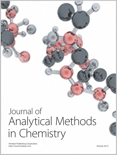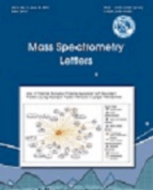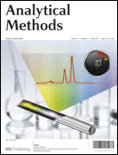
Journal of Analytical Methods in Chemistry
Scope & Guideline
Empowering researchers with open access to cutting-edge findings.
Introduction
Aims and Scopes
- Innovative Analytical Techniques:
The journal emphasizes the development and validation of new analytical techniques using cutting-edge technologies such as mass spectrometry, chromatography, and electrochemical methods. - Environmental and Food Safety Analysis:
Research focusing on the analysis of environmental samples and food safety, including the detection of contaminants, pesticides, and heavy metals. - Pharmacokinetics and Drug Analysis:
Studies on drug analysis, pharmacokinetics, and the development of methods for quantifying pharmaceutical compounds in biological matrices. - Multicomponent Analysis and Chemometrics:
Utilization of chemometric techniques for the analysis of complex mixtures, improving the accuracy and efficiency of analytical methods. - Natural Products and Herbal Medicine:
Exploration of analytical methods for the characterization and quantification of bioactive compounds in traditional and herbal medicines.
Trending and Emerging
- Point-of-Care Testing and Biosensors:
A significant increase in research on point-of-care testing methods and biosensors has been observed, reflecting the demand for rapid and accessible diagnostic tools in clinical and environmental applications. - Green Analytical Chemistry:
There is a growing emphasis on environmentally friendly analytical methods that minimize waste and reduce the use of hazardous materials, aligning with global sustainability goals. - Advanced Mass Spectrometry Techniques:
The use of advanced mass spectrometry techniques, including ultra-high-performance liquid chromatography coupled with tandem mass spectrometry (UHPLC-MS/MS), has become increasingly prominent in the journal, showcasing innovations in sensitivity and resolution. - Network Pharmacology and Chemometric Approaches:
Emerging research incorporating network pharmacology and chemometric analyses for the study of complex biological systems and interactions of natural products is gaining traction, reflecting interdisciplinary collaboration. - Nanomaterials in Analytical Applications:
The application of nanomaterials in analytical chemistry, particularly in sensor development and environmental monitoring, is on the rise, highlighting the innovative potential of nanotechnology in enhancing analytical performance.
Declining or Waning
- Traditional Analytical Methods:
There has been a noticeable decrease in publications focused on classical analytical techniques, such as simple UV-Vis spectrophotometry and basic titrimetric methods, as researchers increasingly adopt more sophisticated and sensitive methodologies. - General Reviews without Novel Contributions:
The journal has seen fewer general review articles that do not introduce new methodologies or significant advancements in the field, indicating a preference for original research that offers novel insights. - Limited Focus on Basic Chemical Analysis:
Research focusing solely on basic chemical analysis without application to specific problems or advanced methodologies appears to be declining, as the journal seeks to prioritize studies with broader implications.
Similar Journals

Mass Spectrometry Letters
Exploring Innovative Frontiers in Analytical Chemistry.Mass Spectrometry Letters is a pioneering open-access journal published by the Korean Society for Mass Spectrometry, specializing in the diverse fields of analytical chemistry, biochemistry, and spectroscopy. Established in 2010, this journal aims to disseminate groundbreaking research and advancements in mass spectrometry and its applications across various scientific domains. Though currently categorized in the Q4 quartile in key analytical fields, Mass Spectrometry Letters serves as an essential platform for researchers, professionals, and students to share innovative methodologies, emerging trends, and practical applications of mass spectrometry, thus fostering collaboration and advancing knowledge in the scientific community. With a commitment to open access, articles published since 2010 are readily available, enabling widespread distribution and engagement within the international research community. Located in Daejeon, South Korea, and actively converging research through 2024, the journal holds the potential to grow its impact and relevance within the dynamic landscape of mass spectrometry.

Methods and Objects of Chemical Analysis
Championing Methodological Rigor in Chemical ResearchMethods and Objects of Chemical Analysis is a significant outlet in the field of Analytical Chemistry, published by the prestigious TARAS SHEVCHENKO NATIONAL UNIVERSITY OF KYIV in Ukraine. Since its inception in 2017, this journal has aimed to advance methodological and analytical understanding within the discipline, addressing contemporary issues and innovative techniques. With a Scopus rank of #133 out of 156 and a Q4 Category Quartile for 2023, it offers a platform for researchers and professionals to disseminate crucial findings and methodologies. While currently serving as a traditional journal, it is fostering an academic community focused on impactful research that enhances our understanding of chemical analysis techniques. The journal’s commitment to scholarly rigor and its relevance in a rapidly evolving field make it a valuable resource for students and seasoned researchers alike, seeking to remain at the forefront of analytical advancements.

Journal of Analysis and Testing
Elevating standards in analytical and environmental science.Journal of Analysis and Testing is a premier academic journal published by SPRINGER SINGAPORE PTE LTD, dedicated to advancing the fields of analytical and environmental chemistry. With ISSN 2096-241X and E-ISSN 2509-4696, the journal has established a significant presence since its inception in 2017, converging its focus until 2024. The journal's outstanding rankings in 2023, including Q1 quartile placements in Analytical Chemistry, Instrumentation, and Spectroscopy, underscore its pivotal role in disseminating high-quality research. Researchers can access cutting-edge studies that explore innovative testing methodologies, electrochemical analyses, and material evaluations, making it an essential resource for professionals and students alike. The Journal of Analysis and Testing not only celebrates advances in science and technology but also promotes interdisciplinary collaborations, ensuring widespread impact across analytical and environmental domains. As such, this journal plays a vital role in shaping the future of analytical practices and methodologies, positioning itself as a key conduit for knowledge exchange in the scholarly community.

Analytical Methods
Pioneering Research in Analytical TechniquesAnalytical Methods, published by the renowned Royal Society of Chemistry, is a distinguished journal that has been serving the scientific community since its inception in 2009. Specializing in the fields of Analytical Chemistry, Chemical Engineering, and General Engineering, this journal holds a reputable position with an impressive Q2 ranking in three relevant categories as of 2023. With its focus on innovative methodologies and advanced applications in analytical science, it aims to disseminate cutting-edge research and foster dialogue among researchers, professionals, and students. Although it is not an open access publication, it is accessible worldwide and provides critical insights into the latest developments in analytical techniques and their engineering applications. The journal also ranks highly in pertinent Scopus categories, such as being in the 77th percentile for General Engineering and 61st percentile for Analytical Chemistry, underlining its significance in advancing knowledge and practical applications in these fields. By participating in this journal, readers can expect to engage with high-quality research that influences the future of analytical practices and chemical engineering.

Analytical Science and Technology
Exploring the forefront of analytical techniques and insights.Analytical Science and Technology is a prominent journal dedicated to advancing the fields of analytical chemistry and technology, published by the Korean Society for Analytical Science. Based in South Korea, this journal serves as a vital platform for researchers, professionals, and students committed to exploring innovative analytical techniques and methodologies. Although it is classified under Q4 in various subject categories, including Agronomy and Crop Science, Environmental Chemistry, and Pharmacology, the journal aims to provide critical insights and contributions to the scientific community. With ISSN 1225-0163 and E-ISSN 2288-8985, it spans a converged timeline from 2019 to 2024. Despite its current standings in Scopus rankings, the journal is dedicated to improving its visibility and impact through rigorous peer review and high-quality publications, fostering knowledge sharing within its diverse academic fields. Researchers looking for a reliable outlet for their findings are encouraged to consider this journal as it continues to strive for excellence in analytical science.

CHINESE JOURNAL OF ANALYTICAL CHEMISTRY
Connecting Minds in the World of Analytical ChemistryCHINESE JOURNAL OF ANALYTICAL CHEMISTRY, published by SCIENCE PRESS in China, stands as a prominent platform in the field of analytical chemistry since its inception in 1989. With its ISSN 0253-3820 and E-ISSN 1872-2040, the journal maintains a vital role in disseminating empirical research and innovative methodologies, contributing to the advancement of analytical techniques and their applications. The 2023 Scopus ranking positions the journal in the third quartile (Q3) within its category, reflecting a respectable standing among its peers. Researchers, professionals, and students alike engage with a broad range of topics, from instrumental analysis to environmental monitoring, each aiming to foster further scientific inquiry. Although it does not currently offer Open Access, the journal's rich repository of knowledge continues to be an essential resource for those in the analytical chemistry community, with an enduring commitment to scientific excellence and collaboration.

INTERNATIONAL JOURNAL OF ENVIRONMENTAL ANALYTICAL CHEMISTRY
Illuminating the path to cleaner, healthier ecosystems.INTERNATIONAL JOURNAL OF ENVIRONMENTAL ANALYTICAL CHEMISTRY, published by Taylor & Francis Ltd, stands as an essential resource in the interdisciplinary field of environmental science and analytical chemistry. With a history dating back to 1971 and a convergence period extending to 2024, this journal addresses urgent global challenges by providing a platform for high-quality research that encompasses pivotal aspects of environmental analysis, pollution, and public health. The journal’s significant impact is reflected in its 2023 rankings, placing it in the second and third quartiles across various relevant categories, including Analytical Chemistry, Environmental Chemistry, and Water Science and Technology. Researchers and practitioners are encouraged to contribute to its wealth of knowledge, making it a vital reference for emerging studies in Health, Toxicology and Mutagenesis and beyond. Although it is not an open-access journal, subscriptions provide unparalleled access to groundbreaking research that can influence both academia and industry practices.

JOURNAL OF FOOD AND DRUG ANALYSIS
Connecting Science to Society through Food and Drug ResearchJOURNAL OF FOOD AND DRUG ANALYSIS, an esteemed publication in the realms of Food Science and Pharmacology, is published by DIGITAL COMMONS BEPRESS. With an impactful commitment to open access since 2013, this journal facilitates the dissemination of critical research findings, making them readily available to a global audience. Boasting a commendable Q2 ranking in both Food Science and Pharmacology, the journal occupies a prominent position in its respective categories, reflecting its quality and relevance in the field. Established in 1994, the journal has successfully converged its focus to encompass a wide range of topics related to the analysis of food and drugs, thereby providing valuable insights to researchers, practitioners, and students alike. With its indexed indicators in Scopus showcasing a strong performance—ranking #85 among 389 in Food Science and #108 among 313 in Pharmacology—it stands as a crucial platform for the advancement of knowledge and innovation. For those looking to stay abreast of pivotal developments in food safety and drug efficacy, JOURNAL OF FOOD AND DRUG ANALYSIS is an indispensable resource.

JOURNAL OF CHROMATOGRAPHY A
Unveiling Breakthroughs in BiochemistryJOURNAL OF CHROMATOGRAPHY A, published by Elsevier, is a leading journal in the disciplines of Analytical Chemistry, Biochemistry, and Organic Chemistry, boasting an impressive 2023 Q2 categorization across multiple fields. With an ISSN of 0021-9673 and an E-ISSN of 1873-3778, this prestigious journal has been at the forefront of chromatography research since its inception in 1958. The journal serves as a vital platform for disseminating high-quality research articles, reviews, and insights into the latest developments in chromatographic techniques and applications, reflecting its standing in the top tier of analytical and organic chemistry literature, evidenced by its impressive Scopus rankings. While it currently operates under a subscription model, the journal continues to make significant contributions to the scientific community by fostering collaboration and innovation in chromatography methodologies. We invite researchers, professionals, and students to engage with the essential findings shared within its pages, which are foundational for advancements in various scientific fields, making it an indispensable resource for enhancing chromatographic knowledge and practice.

BUNSEKI KAGAKU
Connecting Researchers Through Quality ScholarshipBUNSEKI KAGAKU, published by the Japan Society Analytical Chemistry, is a reputable journal dedicated to the field of analytical chemistry. With an ISSN of 0525-1931, this journal has been a crucial outlet for scholarly communication since its inception in 1952, converging its publication years from 1954 to 1957 and from 1959 to 2024. Although it holds a Q4 category ranking in the most recent 2023 quartiles of analytical chemistry and ranks 153/156 in Scopus, it continues to serve as a platform for quality research, fostering advancements in the field. BUNSEKI KAGAKU is based in Tokyo, Japan, and emphasizes the critical importance of analytical techniques in scientific inquiry. With a commitment to professionalism and rigor, the journal provides a vital resource for researchers, students, and professionals seeking to explore innovative methodologies and contribute to the ongoing dialogue in analytical chemistry.